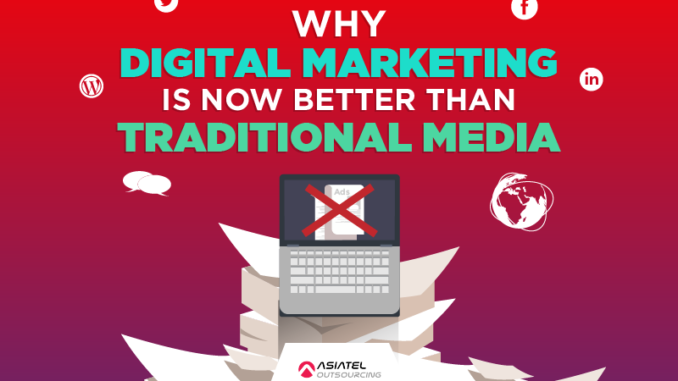

Since the upsurge of digitalization of information and business, most people depend almost all of their activities online. And marketers take note of it. They have to be in a place where the audience is for their strategies to work.
It is the mark of the inception of digital marketing or advertising as it has been continuously adopted by businesses worldwide. Digital ad spending in the United States is expected to exceed the traditional way. In 2023, according to the latest eMarketer’s latest forecast, digital ad spending will be 2/3s superior to total media spending.
There will be no expected decline in the successful shift from print and TV to social media and online ads in the next decade. The two main perpetrators of this are Google and Facebook. True enough, we almost get all the information from searching on Google and, Facebook, who doesn’t have a Facebook account, right? From the same forecast, US advertisers are said to spend $129 billion on digital advertising, $10 billion more than traditional advertising of $109 billion.
Traditional marketers would still argue their ways but there are a lot of factual and practical reasons because of this shift.
1. Digital is way cheaper.
Traditional marketing may cost up to a hundred thousand bucks for a decent design on print or a 15-second TV commercial. If digital, you can get away with it with just a few bucks since the audience is already there (well, virtually) and the dissemination of the materials is just one share or click away.
Zenith reported that TV ad spending is losing its momentum and that it is expecting a $2 billion decrease in its total global ad spending. That’s major.
2. Digital is more targeted.
When a print ad, let’s say in a newspaper, anybody can read it. Some may argue that it is still targeted since the age group of those who often read newspapers belong to a specific demographic. When it comes to digital, there are also tailored ads targeting a specific demographic, and it is effective since it uses an algorithm that goes beyond search histories and buying behavior, what are the triggers and such. Personalization is the key, and that is why it is more successful.
Ever had the experience that after browsing a product, let’s say smartphones, there will be sponsored ads on your social media account of the newest smartphones in the market?
3. Digital is trackable.
Google Analytics is one of the tools you can use to track the reception and effectivity of an ad. It will show you the exact figures regarding the performance of specific marketing material. Unlike TV ads, for instance, all you have are ratings from Nielsen, which will only provide an estimate. As a marketer, you need exact results and data about how it is received by the target audience.
Using these gathered data, you can make future adjustments on its placement for better results.
4. Digital is more versatile.
On TV, you can only show limited content the same as print because it is riskier considering the audience is not controlled. In digital, though seems like an ocean of information, you can make adjustments.
Also, almost everything you can do in print and TV can also be done online. From commercials, promotional blogs, reviews, infographics and more. It is almost limitless compared to the traditional ways that are restricted to the length of a video or space of a lay-outed content.
Lastly, there is no room for mistakes in the traditional, or else everything will end up in an erratum statement or a damaged reputation. We know how call-out culture works today. The flexibility of digital ways makes you do edits or improvements even at the last minute.
The fact the most consumers approve ads especially if it’s personalized is one of the many proofs of the rise of digital marketing. To be fair, digital can still be considered effective but digital marketing is now on another level. Either way, it is not bad news as the audience, platforms and ways are just evolving and adapting to societal changes.
The post Why Digital Marketing Is Now Better Than Traditional Media appeared first on Asia Telecom Outsourcing.
